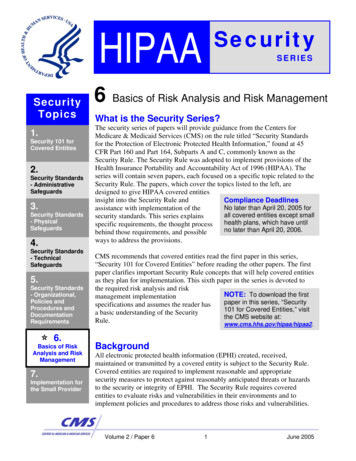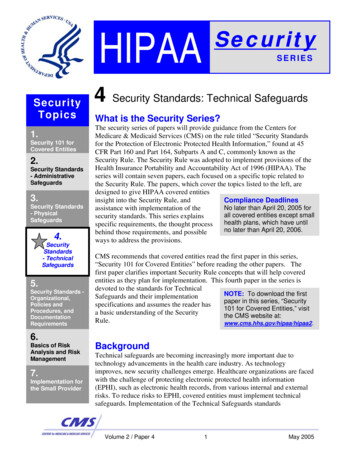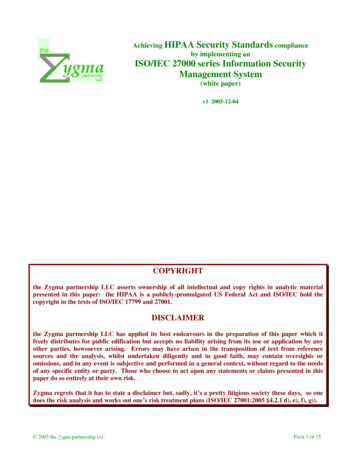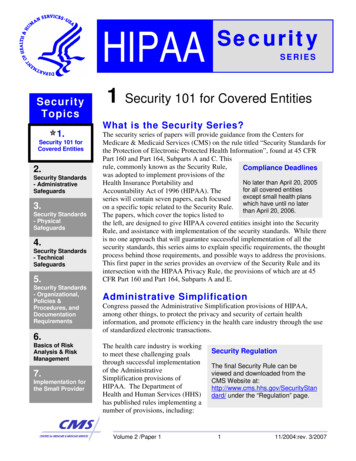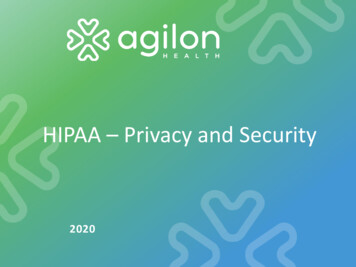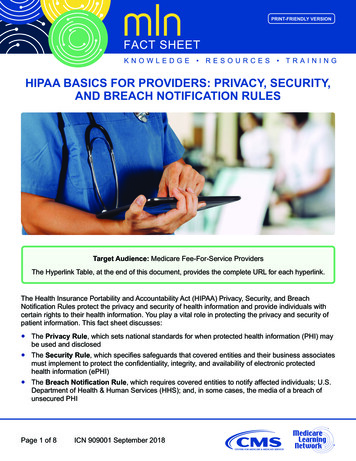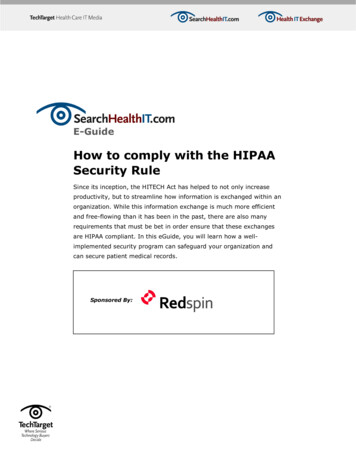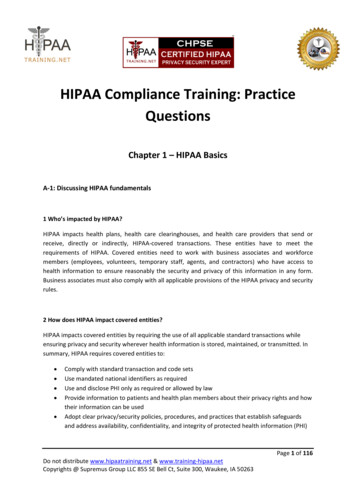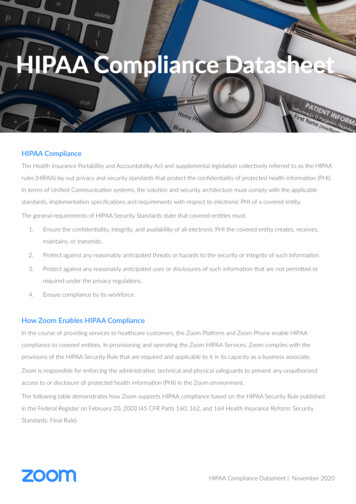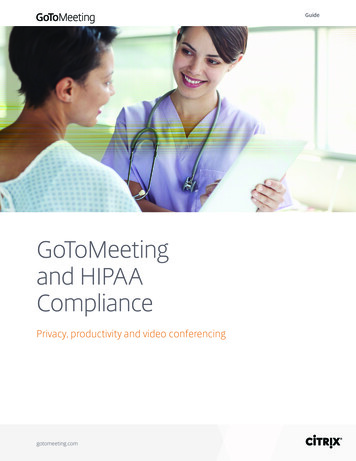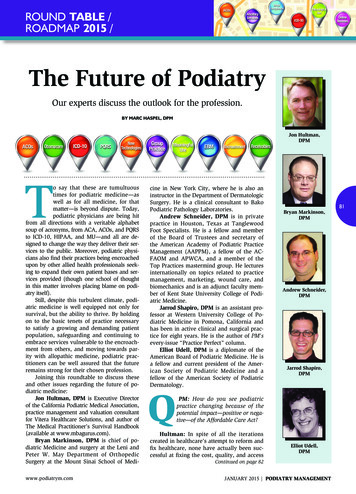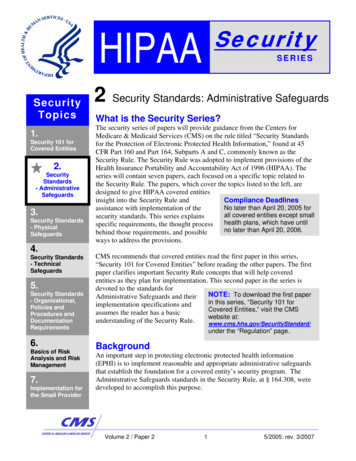
Transcription
SecurityHIPAASecurityTopics1.Security 101 forCovered Entities5.Security 2.Standards- s,and- .Security Standards- PhysicalSafeguards4.Security Standards- TechnicalSafeguards5.Security Standards- Organizational,Policies andProcedures andDocumentationRequirements6.Basics of RiskAnalysis and RiskManagement7.Implementation forthe Small ProviderSERIES2 Security Standards: Administrative SafeguardsWhat is the Security Series?The security series of papers will provide guidance from the Centers forMedicare & Medicaid Services (CMS) on the rule titled “Security Standardsfor the Protection of Electronic Protected Health Information,” found at 45CFR Part 160 and Part 164, Subparts A and C, commonly known as theSecurity Rule. The Security Rule was adopted to implement provisions of theHealth Insurance Portability and Accountability Act of 1996 (HIPAA). Theseries will contain seven papers, each focused on a specific topic related tothe Security Rule. The papers, which cover the topics listed to the left, aredesigned to give HIPAA covered entitiesinsight into the Security Rule andCompliance DeadlinesNo later than April 20, 2005 forassistance with implementation of theall covered entities except smallsecurity standards. This series explainshealth plans, which have untilspecific requirements, the thought processno later than April 20, 2006.behind those requirements, and possibleways to address the provisions.CMS recommends that covered entities read the first paper in this series,“Security 101 for Covered Entities” before reading the other papers. The firstpaper clarifies important Security Rule concepts that will help coveredentities as they plan for implementation. This second paper in the series isdevoted to the standards forNOTE: To download the first paperAdministrative Safeguards and theirin this series, “Security 101 forimplementation specifications andCovered Entities,” visit the CMSassumes the reader has a basicwebsite at:understanding of the Security Rule.www.cms.hhs.gov/SecurityStandard/under the “Regulation” page.BackgroundAn important step in protecting electronic protected health information(EPHI) is to implement reasonable and appropriate administrative safeguardsthat establish the foundation for a covered entity’s security program. TheAdministrative Safeguards standards in the Security Rule, at § 164.308, weredeveloped to accomplish this purpose.Volume 2 / Paper 215/2005: rev. 3/2007
2 Security Standards: Administrative SafeguardsHIPAA SECURITYSTANDARDSThe objectives of this paper are to:Review each Administrative Safeguards standard andimplementation specification listed in the Security Rule.Security Standards:General Rules---ADMINISTRATIVESAFEGUARDSSecurity ManagementProcessAssigned SecurityResponsibilityWorkforce SecurityInformation AccessManagementSecurity Awarenessand TrainingSecurity IncidentProceduresContingency PlanEvaluationBusiness AssociateContracts and OtherArrangementsPHYSICALSAFEGUARDSFacility AccessControlsWorkstation UseWorkstation SecurityDevice and MediaControlsTECHNICALSAFEGUARDSAccess ControlSTANDARDAudit ControlsIntegrity164.310(a)(1)Person or EntityAuthenticationTransmission SecurityORGANIZATIONALREQUIREMENTS- Business AssociateContracts and OtherArrangements- Requirements forGroup Health PlansPOLICIES andPROCEDURES andDOCUMENTATIONREQUIREMENTSDiscuss the purpose for each standard.Provide sample questions that covered entities may want toconsider when implementing the Administrative Safeguards.Sample questions provided in this paper, and other HIPAA Security Seriespapers, are for consideration only and are not required for implementation.The purpose of the sample questions is to promote review of a coveredentity’s environment in relation to the requirements of the Security Rule.The sample questions are not HHS interpretations of the requirements of theSecurity Rule.All the information presented in the Security Series is designed to furthercovered entities’ understanding of the Security Rule concepts. The papersare not intended to be the definitive guidance for covered entity compliance.Compliance with the Security Rule will depend on a number of factors,including those identified in § 164.306(b)(2):“(i)(ii)(iii)(iv)The size, complexity, and capabilities of the coveredentity.The covered entity's technical infrastructure,hardware, and software security capabilities.The costs of security measures.The probability and criticality of potential risks toEPHI.”What are Administrative Safeguards?The Security Rule defines administrative safeguards as, “administrativeactions, and policies and procedures, to manage the selection, development,implementation, and maintenance of security measures to protect electronicprotected health information and to manage the conduct of the coveredentity’s workforce in relation to the protection of that information.”The Administrative Safeguards comprise over half of the HIPAA Securityrequirements. As with all the standards in this rule, compliance with theAdministrative Safeguards standards will require an evaluation of theVolume 2 / Paper 225/2005: rev. 3/2007
2 Security Standards: Administrative Safeguardssecurity controls already in place, an accurate and thorough risk analysis, and a series ofdocumented solutions derived from a number of factors unique to each covered entity.STANDARD§ 164.308(a)(1)Security Management ProcessThe first standard under Administrative Safeguards section is the Security Management Process.This standard requires covered entities to:“Implement policies and procedures to prevent, detect, contain andcorrect security violations.”The purpose of this standard is to establish the administrative processes and procedures that acovered entity will use to implement the security program in its environment. There are fourimplementation specifications in the Security Management Process standard.1.2.3.4.NOTE: For a more detaileddiscussion of “addressable” and“required” implementationspecifications, see the firstpaper in this series, “Security101 for Covered Entities.”Risk Analysis (Required)Risk Management (Required)Sanction Policy (Required)Information System Activity Review(Required)The Importance of Risk Analysis and Risk ManagementRisk analysis and risk management are critical to a covered entity’s Security Rule complianceefforts. Both are standard information security processes that have already been adopted by someorganizations within the health care industry.As stated in the responses to public comment in the preamble to the Security Rule, the SecurityManagement Process standard and associated implementation specifications “form thefoundation upon which an entity’s necessary security activities are built.” The results from therisk analysis and risk management processes will become the baseline for security processeswithin covered entities.This paper provides a general understanding of risk analysisand risk management concepts and processes. CMS willinclude a more detailed discussion of risk analysis and riskmanagement in paper 6 in the HIPAA Security Series titled,“Basics of Risk Analysis and Risk Management.”Volume 2 / Paper 23NOTE: Risk analysis and riskmanagement serve as tools toassist in the development of acovered entity’s strategy toprotect the confidentiality,integrity, and availability ofEPHI.5/2005: rev. 3/2007
2 Security Standards: Administrative Safeguards1. RISK ANALYSIS (R) - § 164.308(a)(1)(ii)(A)The Risk Analysis implementation specification requires covered entities to:“Conduct an accurate and thorough assessment of the potential risks andvulnerabilities to the confidentiality, integrity, and availability ofelectronic protected health information held by the covered entity.”In general, a risk analysis can be viewed as:The process of identifying potential security risks, andDetermining the probability of occurrence and magnitude of risks.Sample questions for covered entities to consider:How does EPHI flow throughout the organization? This includes EPHI thatis created, received, maintained or transmitted by the covered entity.What are the less obvious sources of EPHI? Has the organization consideredportable devices like PDAs?What are the external sources of EPHI? For example, do vendors orconsultants create, receive, maintain or transmit EPHI?What are the human, natural, and environmental threats to informationsystems that contain EPHI?2. RISK MANAGEMENT (R) - § 164.308(a)(1)(ii)(B)Risk Management is a required implementation specification. It requires an organizationto make decisions about how to address security risks and vulnerabilities. The RiskManagement implementation specification states that covered entities must:“Implement security measures sufficient to reduce risks andvulnerabilities to a reasonable and appropriate level to comply with§164.306(a).”Risk management is the process used to identify and implement security measures toreduce risk to a reasonable and appropriate level within the covered entity based on thecovered entity’s circumstances. The measures implemented to comply with this requiredimplementation specification must also allow the covered entity to comply with §Volume 2 / Paper 245/2005: rev. 3/2007
2 Security Standards: Administrative Safeguards164.306(a) of the Security Standards: General Rules. Covered entities will want toanswer some basic questions when planning their risk management process.Sample questions for covered entities to consider:What security measures are already in place to protect EPHI (i.e.,safeguards)?Is executive leadership and/or management involved in risk managementand mitigation decisions?Are security processes being communicated throughout the organization?Does the covered entity need to engage other resources to assist in riskmanagement?In general, a covered entity will want to make sure itsrisk management strategy takes into account thecharacteristics of its environment including thefactors at § 164.306(b)(2), which are listed on page 2of this paper. These factors will help the coveredentity to determine what potential security measuresare reasonable and appropriate for its environment.NOTE: Covered entities mustensure that the risk analysisand risk managementprocesses are on-going anddynamic processes that canchange as the environment oroperations change.3. SANCTION POLICY (R) - § 164.308(a)(1)(ii)(C)Another implementation specification in the Security Management Process is theSanction Policy. It requires covered entities to:“Apply appropriate sanctions against workforce members who fail tocomply with the security policies and procedures of the covered entity.”Appropriate sanctions must be in place so that workforce members understand theconsequences of failing to comply with security policies and procedures, to deternoncompliance.Sample questions for covered entities to consider:Does the covered entity have existing sanction policies and procedures tomeet the requirements of this implementation specification? If not, canVolume 2 / Paper 255/2005: rev. 3/2007
2 Security Standards: Administrative Safeguardsexisting sanction policies be modified to include language relating toviolations of these policies and procedures?Does the organization require employees to sign a statement of adherence tosecurity policy and procedures (e.g., as part of the employee handbook orconfidentiality statement) as a prerequisite to employment?Does the statement of adherence tosecurity policies and procedures statethat the workforce memberacknowledges that violations of securitypolicies and procedures may lead todisciplinary action, for example, up toand including termination?NOTE: A covered entity’ssanction policy should reinforceits security policies andprocedures.Does the sanction policy provide examples of potential violations of policyand procedures?Does the sanction policy adjust the disciplinary action based on the severityof the violation?4. INFORMATION SYSTEM ACTIVITY REVIEW (R) - § 164.308(a)(1)(ii)(D)The Security Management Process standard also includes the Information SystemActivity Review implementation specification. This required implementationspecification states that covered entities must:“Implement procedures to regularly review records of information systemactivity, such as audit logs, access reports, and security incident trackingreports.”The information system activity review enables covered entities to determine if any EPHIis used or disclosed in an inappropriate manner.Information system activity review procedures may be different for each covered entity.The procedure should be customized to meet the covered entity’s risk managementstrategy and take into account the capabilities of all information systems with EPHI.Volume 2 / Paper 265/2005: rev. 3/2007
2 Security Standards: Administrative SafeguardsSample questions for covered entities to consider:What are the audit and activity review functions of the current informationsystems?Are the information systems functionsadequately used and monitored topromote continual awareness ofinformation system activity?What logs or reports are generated bythe information systems?NOTE: The InformationSystem Activity Reviewimplementation specificationshould also promote continualawareness of any informationsystem activity that couldsuggest a security incident.Is there a policy that establishes what reviews will be conducted?Is there a procedure that describes specifics of the reviews?STANDARD§ 164.308(a)(2)Assigned Security ResponsibilityThe second standard in the Administrative Safeguards section is Assigned SecurityResponsibility. There are no separate implementation specifications for this standard. Thestandard requires that covered entities:“Identify the security official who is responsible for the development andimplementation of the policies and procedures required by this subpart[the Security Rule] for the entity.”The purpose of this standard is to identify who will be operationally responsible for assuring thatthe covered entity complies with the Security Rule. Covered entities should be aware of thefollowing when assigning security responsibility:This requirement is comparable to the Privacy Rule standard at§164.530(a)(1), Personnel Designations, which requires all covered entities todesignate a Privacy Official.The Security Official and Privacy Official can be the same person, but are notrequired to be.Volume 2 / Paper 275/2005: rev. 3/2007
2 Security Standards: Administrative SafeguardsWhile one individual must be designated as having overall responsibility,other individuals in the covered entity may be assigned specific securityresponsibilities (e.g., facility security or network security).When making this decision covered entities should consider some basic questions.Sample questions for covered entities to consider:Would it serve the organization’s needs to designate the same individual asboth the Privacy and Security Official (for example, in a small provideroffice)?Has the organization agreed upon, and clearly identified and documented,the responsibilities of the Security Official?How are the roles and responsibilities of the Security Official crafted toreflect the size, complexity and technical capabilities of the organization?STANDARD§ 164.308(a)(3)Workforce SecurityThe third standard is Workforce Security, which states that covered entities must:“Implement policies and procedures to ensure that all members of itsworkforce have appropriate access to electronic protected healthinformation, as provided under [the Information Access Managementstandard], and to prevent those workforce members who do not haveaccess under [the Information Access Management standard] fromobtaining access to electronic protected health information.”Within a covered entity’s environment, workforce members that need access to EPHI to carryout their duties must be identified. For each workforce member, or job function, the coveredentity must identify the EPHI that is needed, when it is needed, and make reasonable efforts tocontrol access to the EPHI. This will also include identification of the computer systems andapplications that provide access to the EPHI. Covered entities must provide only the minimumnecessary access to EPHI that is required for a workforce member to do his or her job.Within Workforce Security there are three addressable implementation specifications.1. Authorization and/or Supervision (Addressable)Volume 2 / Paper 285/2005: rev. 3/2007
2 Security Standards: Administrative Safeguards2. Workforce Clearance Procedure (Addressable)3. Termination Procedures (Addressable)1. AUTHORIZATION AND/OR SUPERVISION (A) – § 164.308(a)(3)(ii)(A)Where the Authorization and/or Supervision implementation specification is a reasonableand appropriate safeguard for a covered entity, the covered entity must:“Implement procedures for the authorization and/or supervision ofworkforce members who work with electronic protected healthinformation or in locations where it might be accessed.”Authorization is the process of determining whether a particular user (or a computersystem) has the right to carry out a certain activity, such as reading a file or running aprogram. Implementation of this addressable implementation specification will varyamong covered entities, depending upon the size and complexity of the workforce, andthe information systems that contain EPHI. ForNOTE: The Authorizationexample, in a very small provider office, all staffand/orSupervisionmembers may need to access all EPHI in theirimplementationspecificationinformation system, since they may perform multipleprovides the necessary checksfunctions. In this case, the covered entity mightand balances to ensure that alldocument the reasons for implementing policies andmembers of the workforce haveprocedures allowing this kind of global access. If theappropriate access (or, in somedocumented rationale is reasonable and appropriate,cases, no access) to EPHI.this may be an acceptable approach.To determine the most reasonable and appropriate authorization and/or supervisionprocedures, covered entities may want to ask some basic questions about existing policiesand procedures.Sample questions for covered entities to consider:Are detailed job descriptions used to determine what level of access theperson holding the position should have to EPHI?Who has or should have the authority to determine who can access EPHI,e.g., supervisors or managers?Are there similar existing processes used for paper records that could beused as an example for the EPHI?Volume 2 / Paper 295/2005: rev. 3/2007
2 Security Standards: Administrative SafeguardsCovered entities should review the authorization and supervision policies already presentin the organization’s current operating environment. Depending on the existing policies,covered entities may need to reinforce them, make modifications for EPHI, and/ordevelop corresponding documentation.2. WORKFORCE CLEARANCE PROCEDURE (A) - § 164.308(a)(3)(ii)(B)Covered entities need to address whether all members of the workforce with authorizedaccess to EPHI receive appropriate clearances. Where the Workforce ClearanceProcedure implementation specification is a reasonable and appropriate safeguard for acovered entity, the covered entity must:“Implement procedures to determine that the access of a workforcemember to electronic protected health information is appropriate.”In other words, the clearance process must establish the procedures to verify that aworkforce member does in fact have the appropriate access for their job function. Acovered entity may choose to perform this type of screening procedure separate from oras a part of the authorization and/or supervision procedure.Sample questions for covered entities to consider:Are there existing procedures for determining that the appropriate workforcemembers have access to the necessary informat
Apr 20, 2005 · HIPAA Security SERIES Compliance Deadlines No later than April 20, 2005 for all covered entities except small health plans, which have until no later than April 20, 2006. NOTE: To download the first paper in this series, “Security 101 for Covered Entities,” visit the CMS
